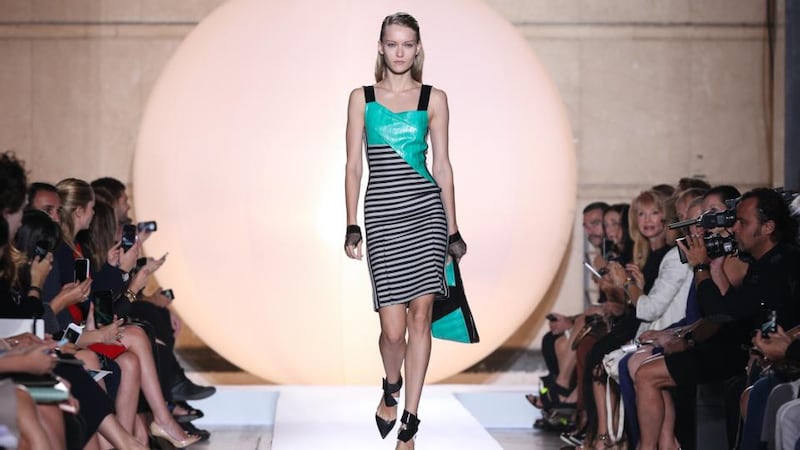He will go down in history as the man who created the Galaxy dress, the frock that rocked red carpets, defined the shape of the noughties and spawned waiting lists all over the world.
The genius of British-based French designer Roland Mouret was to create a silhouette that was decorous but sexy; cut with precision but tailored to womanly curves – and totally new. “A dress is a tool,” he once said, “and a tool has to work.”
When we meet at his London headquarters, he explains that his technique involves draping fabric on the body, folding, nipping and tucking rather than drawing.


“I think all the time about body shape – about muscle, bone, fat working together – and analysing how everything moves from one side to another,” he says.
“In my head dresses have to be as practical as a pair of jeans. My dresses are not finished until there is a body inside them.”
His Mayfair flagship, which opened two years ago, is on the curvature of Carlos Place, in a handsome Edwardian building that formerly housed a bank and embassy. Neighbouring shops include Lanvin, Balenciaga, Marc Jacobs and Nicholas Kirkwood with the luxury Connaught Hotel just across the road.
A mimosa tree and large banner proclaim the entrance and the first floor houses the “Signature Room” in which hang new versions of the Galaxy and its equally celebrated successor, the Moon dress.
“We issue them every season,” says head of PR Diane Crook, “and they are only sold here and online.”
Upstairs on the top floor is Mouret’s stark, spacious studio with a large white desk, a rack of samples and a ceiling-to-floor mirror.
On the mantelpiece is a random display of cards and images including a photo of him flamboyantly bending over a woman who is draped ballerina-style across his arms: it’s Natalie Massenet, founder of Net-a-Porter. Apart from this, there are no pictures of him with any of his many other celebrity fans, most famously Victoria Beckham who wore a pink Moon dress when her husband joined LA Galaxy (which prompted even Germaine Greer to state it was “unforgettable”). More proudly he shows me a photo of him with one of his two sisters taken in his 20s.
A tall, handsome man with keen brown eyes and a ready, welcoming smile, Mouret radiates an easy familiarity at odds with the more severe poses of his formal portraits.
"This is a bit of Avenue Montaigne in London," he says spreading his hands, comparing the area to one of the most fashionable grandes dames streets of Paris.
Just back from Kuwait and en route to Heuston, Texas, before visiting Dublin next week and then New York, travelling and promoting his collections are part of what he calls “delivering a service and using all the tricks you have to know how to be close to your customer.
“You need to know what their life is. I learn a lot from my customers; where they live and what’s in their wardrobe and what they are going to need in their wardrobe. There is no point in designing what they have already.”
Kuwaiti women, he argues, are the best dressed: “They know how to play with clothes and have a free mind when it comes to dressing. It’s not that far from New York.
“They have the freedom to wear what they want though there is still a certain modesty and the way they control their life is amazing. They have the choice to wear the veil or not – their power is in the choice,” he says.
The notion of service comes from his father, a butcher in Lourdes. “He inspired me and trained me,” says Mouret, “I learnt everything from him.” That included learning to fold his butcher’s whites carefully to hide the blood.
He remembers the Irish pilgrims. He left the city for Paris at 18, spent three months at a fashion college and worked as a model for Jean Paul Gaultier and as creative director of a Paris-based gay publication and as a stylist. “I did many jobs at that time,” he sighs.
He came to London, started making clothes and in 1998 showed them publicly for the first time. Two brothers bought his company, in what turned out to be a doomed relationship. The company lasted just five years: Mouret departed a month after the launch of the Galaxy.
Rescued and relaunched with the help of television mogul Simon Fuller in 2006, Mouret regained his name and their collaboration ever since has been a commercial success. It was once said of Mouret that he understands the spirit and complexities of the red carpet.
“It’s a link,” he says. “And a bad outfit will allow a weakness which will allow a bad picture, so attention to detail is very important. I know enough to make dresses without their being for someone specific. I don’t design with a particular woman in mind. It is more of a sense of movement; what an outfit will allow you to emphasise or hide – my work is to tailor your emotion.”
So what should we be wearing now? “This is a winter of a certain dangerous elegance because we are living in quite a troubled world and you can’t be a target. Animal prints are the thing to wear this season. Fashion attracts reaction and this winter there is a sense of protection in clothing – we are in a protective/reactive mode which is why there are fewer platforms, more flat shoes and lengths are longer. There is more texture in clothing, less minimalism and it’s a little more exotic. When you are a creative person, you have to think about the future all the time.”
Whatever about the future, many of his collections are informed by the past. “For me the 1980s are still so close – it was so extreme and so decadent, but I am not so frightened of that period now. We can take whatever we like from it, and at 52 I am not pretending to be 25. The current hipster movement is all about interest in identity and that is really interesting. Women, regardless of their age, can have a pinch of 80s in their life – they can take whatever they want from it.”
He is at present working on a collection drawing from ethnic groups and contemporary dance. These days his “multi life” includes working three days a week in London and one day in Paris where he is creative director of footwear brand Robert Clergerie.
Weekends are spent with his partner, sculptor James Webster, in their Suffolk cottage with Dave their Jack Russell and Mario a peacock who recently took up residence. “You don’t have to be a designer seven days a week,” he says. “Privacy is important because when you are private you are not competing and we are living in a world of competition. I don’t need to show off to social media.”
His spring collection, coming to Dublin now, inspired by the Palais Royale in Paris and his memories of clubbing in the French capital in the 1980s (“an amazing period”), is strong on graphics: bold black-and-white stripes and a Memphis-like patchwork of colours, fresh and strong.
“I am a big believer in how colour acts on the emotions. Colour can be addictive and there is no fear in people of colour now. People can fall in love with it and I take really seriously the way colour can work against the skin. Green is my best seller followed by blue and red. Emerald green goes with every kind of skin and treating green like black is very clever. Colour gives a sparkle to your eyes. We live in a world of extremes and colours have to be memorable.”
The first to introduce Mouret’s clothes to Ireland 10 years ago when the designer was still a small operator in London’s Kings Road was Tracy Tucker of Costume (the boutique still carries the range). “The fit was always incredible, she recalls. “People would notice that you looked great in the dress rather than the dress looked great on you, if you know what I mean. He cuts for a woman’s body like nobody else.” She also remembers customers “going crazy” for the Galaxy and one young girl wanting one so much that “she asked us to hold it for her while she sold shares to buy it.” The key to the Galaxy’s success, she reckons, was not just the cut, but the power mesh underpinning the construction.
What mistakes do women make, I ask him. “Believing that they are not good enough for the outfit and the tendency to overdo themselves or not do enough – not to have that sharpness about them.
“I like designing for women who enjoy being women and who don’t try to be what they are not. I am always close to a fitted silhouette and some women are surprised that a silhouette exists in themselves . . . we only really see ourselves as we are when we are naked.”
He is equally voluble on the subject of the power of fashion to transform. “You need tools for seduction and clothes allow you to trick the eye and glamour is a trick of the eye. You use an outfit to create a memory of a moment.
“Men often say to me ‘my wife looked so beautiful last night’. They may not remember the dress, but they remember the woman and that private moment.”
As for the future, he is focusing on plans to open a US flagship in New York and concentrate on accessories such as bags, leather goods and sunglasses. A new men’s shoe range will debut next year. “Fashion means that you have to prove that you have new things to say. What I love is that I made a choice to do fashion and the fear is, will I be strong enough some day to stop it?
The Roland Mouret collection is on sale
in Brown Thomas.












